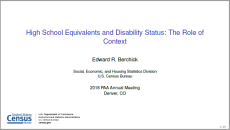
An official website of the United States government
Here’s how you know
Official websites use .gov
A .gov website belongs to an official government organization in the United States.
Secure .gov websites use HTTPS
A lock (
) or https:// means you’ve safely connected to the .gov website. Share sensitive information only on official, secure websites.
-
//
- Census.gov /
- Library /
- Census Working Papers /
- High School Equivalents and Disability Status: The Role of Context
High School Equivalents and Disability Status: The Role of Context
High School Equivalents and Disability Status: The Role of Context
A growing number of individuals in the United States have completed a high school equivalency degree, such as a General Education Development (GED) diploma. Although GED earners and traditional high school graduates are considered to have “equivalent” credentials and have attained identical years of schooling, they face disparate outcomes. For example, GED earners are less healthy than those who have high school diplomas and have health profiles that are generally indistinguishable from—if not worse than—those of high school dropouts. Yet little is known about how these trends may depend on where an individual lives, such as whether s/he lives in an area where GED receipt is common. The current paper investigates the ways in which a local context might modify the negative health outcomes associated with having a GED. Analyses use 2012-2016 five-year American Community Survey (ACS) data to examine geographic variation in the relationship between GED receipt and disability status.
Share
Related Information
Some content on this site is available in several different electronic formats. Some of the files may require a plug-in or additional software to view.
 Yes
Yes
 No
NoComments or suggestions?


Top

